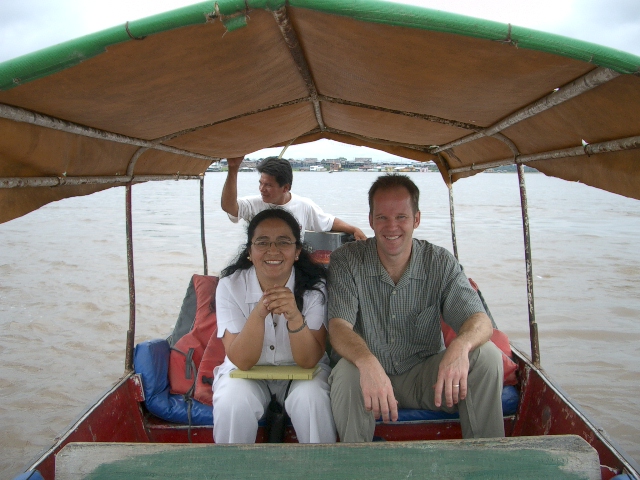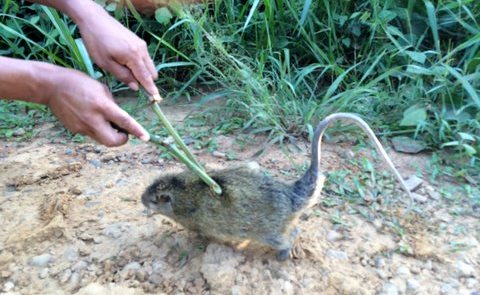Congratulations to 2012-2013 fellow Segundo Leon, who published recently on the evaluation of an immunodiagnostic test for detecting both HIV and syphilis. Read the article in the Journal of Clinical Microbiology.
Month: November 2014 Page 1 of 2

Most of the topics for the bi-weekly conference calls the NPGH Fogarty Fellows participate in are research-related (such as “Tropical Disease and Neurology,”) but the theme for November’s talk was simply “Challenges and Joys.” As Joe Kolars, one of the Principle Investigators from the University of Michigan who led the call put it, this offered a “much-needed chance to take the nose off the grindstone, step back, and reflect on what’s working and what’s not.” Three to four months into their fellowship, most trainees were ready to do just that.
The most common challenge encountered by fellows was frustration over slow-moving research projects. Eleven months is the blink of an eye for bureaucracies and many trainees agreed they had had to modify their plans once they had a better understanding of local procedures and conditions in their study sites. Michael Mahero, a veterinarian working in Uganda, said meeting with some district officials really helped him understand how to help his work move through the approval process and find some “low-hanging fruit” to pick while waiting for everything to come together.
Despite the challenges that come with working in global health, the trainees were excited to share the joys of their fellowship, both personal and professional. Valerie Cortez came back from a month of field work in the Amazon awed by the diversity of butterflies and the beauty of the jungle. Anya Romanoff, who spent the first few months of her fellowship conducting a country-wide survey of breast cancer prevention practices, was happy to have found a warm reception and a permanent study site in Trujillo, Peru. The Thailand team and Uganda fellows felt refreshed from having shared dinners and each other’s company.
Joe Kolars reminded the trainees that dinners with each other or conversations with their mentors to bounce ideas around is one of the best ways to come up with solutions to problems. He remembered from his own early career not wanting to ask his mentors for logistical advice, feeling that it would be a sign of failure. Science is about much more than reagents though, and sometimes success requires good relationships and an understanding of how things work; which can be especially challenging in a foreign culture. Nevertheless, there are plenty of resources and people through the Fogarty network who are happy to help, and who have probably made it through similar struggles. The call ended with warm wishes for the holiday season, which for trainees living south of the equator, will certainly be warm!
by: Nikki Eller

Joseph Zunt, MD MPH is a professor of neurology, global health, and epidemiology at the University of Washington. Originally from Minnesota, he is one of four co-PIs for the NPGH Fogarty Fellows. His research interests include infectious diseases of the central nervous system and education and training.
Joe Zunt first went to Peru on a Fogarty-funded infectious disease fellowship, spending seven months there researching HTLV-1 infections of the central nervous system in a move that would shape his career and life for years to come. Zunt went to Peru with the advice and support of Dr. King Holmes, first Chair of the Department of Global Health at the University of Washington and currently head of the Center for AIDS Research, after a Dr. Joan Kreiss, Director of the UW International AIDS Research and Training Program, advised him that the lack of CT scan machines in Kenya, where Zunt had been planning to go, would make it difficult to study brain infections in patients with AIDS. On his first trip to South America, Zunt forged friendships and professional connections with other researchers with whom he is still collaborating after 19 years.
Although Zunt trained as a neurologist and still spends part of every week in the clinic, it is clear that training and mentoring have become the major focus of his career, and Peru remains the center of many of his projects. The four main grants he co-directs all involve sending researchers back and forth to Peru for training with the ultimate goal of improving the quality of care and research on neurological disorders in that country (and in the entire world if you ask him). Add to that his own research projects on meningoencephalitis, a family life, and regular trips for conferences and workshops and you begin to wonder how he does even a third of that. But remember that strong network of collaborators he has? Nobody plans an “HIV: Mixed Methods and Sociobehavioral Research” workshop in Bangkok by himself.
Perhaps that is why Zunt puts so much of his energy into mentoring; more than just a buzzword, interacting with more experienced researchers is perhaps the most important resource a young scientist can have and Zunt’s own work has gained much from his mentors. He still meets almost daily with Holmes, who set him on his path, although their discussions are more often about the merits of malted milk balls vs. Reese’s Peanut Butter Cups over the office candy jar. When you are not too busy stressing over IRB applications and working on your research, remember to pay attention to the people around you—you never know when a conversation might spark a publication, a friendship, or an Interdisciplinary Cerebrovascular Diseases Training Program in South America.
Author: Nikki Eller. This article was originally published in the NPGH Fogarty Fellows November Newsletter

Valerie Cortez received her PhD in molecular and cell biology from the University of Washington last spring and did her thesis work on HIV vaccine design. She is currently researching zoonotic infectious diseases in Peru as a Fogarty Fellow.
I began my Fogarty Fellowship a little over two months ago, and have spent as much time settling into my new apartment in Lima as I have trekking through the Madre de Dios region of the Peruvian Amazon. I recently returned from my first month-long field work trip to the jungle, and I admittedly found it hard to come back to the city. Although the work was physically demanding, especially in temperatures above 95F/35C, and there were things I lost on the trip—15 lbs, my reluctance to bathe in murky waters—as well as gained—lingering rashes, a plethora of persistent insect bites— I truly enjoyed every minute of it.
I am currently working with my mentor, Dr. Daniel Bausch, and colleagues at the U.S. Naval Medical Research Unit-6 (NAMRU-6) on a five year project to survey rodent populations along the Trans-Oceanic Highway, which bisects a previously remote and undeveloped region of the Amazon. The effects of this highway and the subsequent changes in land use in the area have been dramatic, as the economic opportunities for farming and mining continue to increase. Indeed, I witnessed forest burnings on a daily basis, with the land being cleared for growing papaya, corn, watermelon and other crops. It is unclear how these changes may be impacting the wild rodent populations in the area, and in turn, the microbial communities they harbor, as domestic animals and humans now encroach on these previously undisturbed lands. The potential for zoonotic transmission of rodent-borne pathogens could be significant, and this highlights the need for surveillance in the region. To this end, NAMRU-6 has begun rodent sampling trips four times a year, with each trip directed by a rotating team of two veterinarians, one mammologist, eight field workers, and a few fellow bench scientists. We visit four different towns during each trip and in each town we spend four “trap nights,” setting up over 400 large and small traps across six grids in the areas surrounding the town, each chosen based on their level of land disturbance. Using a delicious concoction of peanut butter, oatmeal, and tuna, we bait the traps at dusk, and then collect them the following day at dawn. In between these times, we process the captured rodents in a makeshift “lab” that we set up and breakdown each day. Powered air-purifying respirators and other personal protective equipment are donned during this time to prevent any potential exposures while we obtain blood samples and biometric data before tattooing the footpads of the animals in order to track whether they are recaptured later in the study. Since my project specifically aims to survey the prevalence of Leptospira species in the environment and rodent communities, when I wasn’t tattooing animals, I collected water samples and inoculated cultures in the field to hopefully obtain isolates of the bacteria, as new species are still being identified.
Overall, I feel like this was an absolutely amazing introduction to field work and I am incredibly fortunate to have had the opportunity to learn about so many new plant and animal species. But I really have my colleagues to thank for having such a fun, productive, and perhaps most importantly, safe field work experience. While I’m excited about the next phase of fellowship setting up assays in the lab, I cannot wait for my next field work trip in January!
This article was originally published in the NPGH Fogarty Fellows November Newsletter

